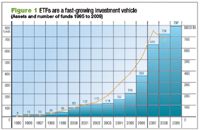- COVID-19
- Biosimilars
- Cataract Therapeutics
- DME
- Gene Therapy
- Workplace
- Ptosis
- Optic Relief
- Imaging
- Geographic Atrophy
- AMD
- Presbyopia
- Ocular Surface Disease
- Practice Management
- Pediatrics
- Surgery
- Therapeutics
- Optometry
- Retina
- Cataract
- Pharmacy
- IOL
- Dry Eye
- Understanding Antibiotic Resistance
- Refractive
- Cornea
- Glaucoma
- OCT
- Ocular Allergy
- Clinical Diagnosis
- Technology
Finances: Discover exchange-traded funds
Understand exchange-traded funds and why you may want one.
Editor's Note: The companies and exchange-traded funds discussed herein are for illustrative purpose only and not a recommendation for the purchase of those specific securities.
-John J. Grande, CFP®, Traudy F. Grande, CFP®, and John S. Grande, CFP®
Q What is an exchange-traded fund (ETF)? Why would I use one?

Like closed-end funds, ETFs can be traded on a secondary market and thus have a market price that may be higher or lower than their net asset value (NAV). The NAV is the total value of a fund's assets less the liabilities. If the ETF shares trade at a price above their NAV, they are said to be trading at a premium.
Conversely, if they are trading at a price below their NAV, they are said to be trading at a discount. For example, if the NAV of the fund is $50 and the fund is selling at $55 on the exchange, the fund is said to be trading at 10% premium to the NAV. If the fund is selling at $45, it is said to be trading at a 10% discount to the NAV.
Typically, ETFs track stock indexes and are offered through a variety of well-known companies, including Barclays, Dow Jones, Merrill Lynch, Standard & Poor's (S&P), and Vanguard.
The oldest and biggest ETF tracks the S&P 500 index. It's called SPDRs, short for Standard & Poor's Depository Receipts and is pronounced "spiders." It began trading on the American Stock Exchange under the symbol SPY.
Since ETFs track specific indexes, their price fluctuates with the performance of the index.
Fast-growing investment vehicle
Innovative offerings in equities, fixed income, and emerging markets have made ETFs one the fastest-growing investment vehicles in the financial industry. ETFs are a popular investment choice among both active and passive investors because of their flexibility to trade like a stock and instant diversification in the form of an index fund. Keep in mind that diversification does not eliminate the risk of investment losses.

